
As 2023 drew to a close, the world stood at the peak of generative AI hype. With tools like ChatGPT, Gemini, MidJourney, and others reshaping industries and igniting imaginations, experts and non-experts alike speculated boldly about what 2024 would bring. Predictions poured in from academics, industry leaders, and AI enthusiasts, forecasting everything from transformative breakthroughs to sobering challenges. Now, as we reflect on 2024, it's time to assess how these predictions fared. Did the bold claims about generative AI materialize, or did reality temper the grand expectations?
Predictions vs. Reality: A Year of Challenges and Progress
1. AI as an Innovation Catalyst
Predictions that AI would supercharge innovation in medicine, health, and education gained traction at the start of the year. In his GatesNotes blog, Bill Gates forecasted that AI would accelerate the pace of new drug discovery by sifting large quantities of data at a rate that wasn’t previously possible; and that AI has the potential to bring a personalized tutor to every student around the world. The results were largely accurate for this prediction.
In healthcare, AI-driven drug discovery made significant progress, with several pharmaceutical companies leveraging AI to identify promising drug candidates faster than ever before. AI also played a growing role in personalized medicine, using patient data to recommend tailored treatment plans.
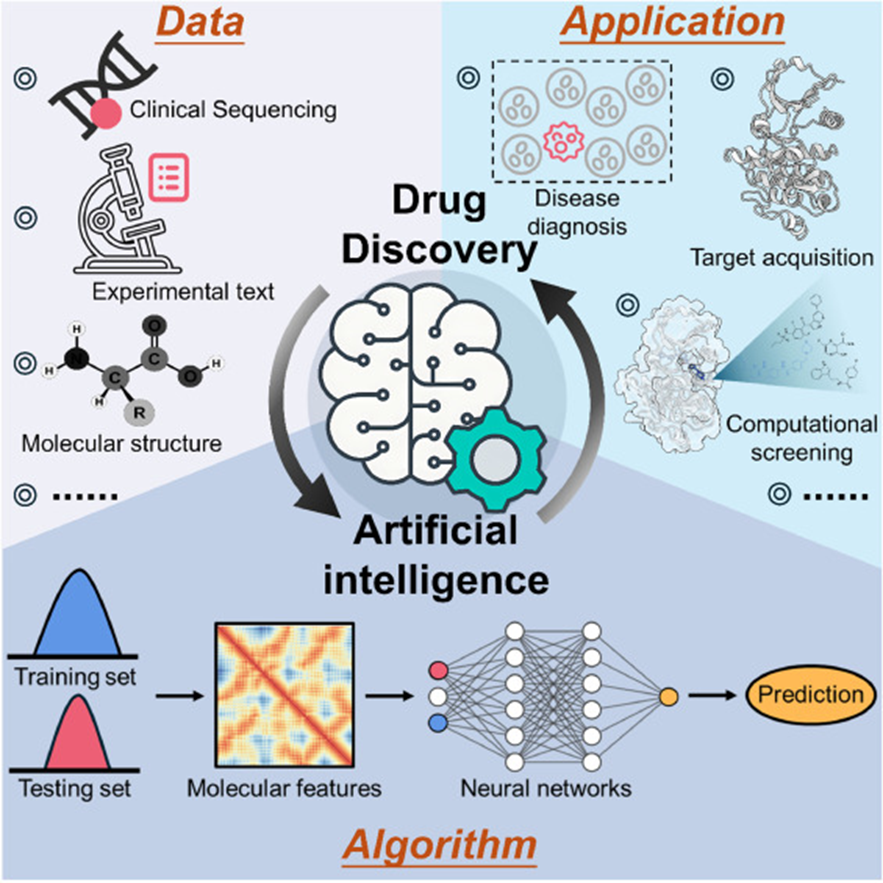
In education, generative AI tools like adaptive learning platforms became more widespread, but concerns about equity and the quality of AI-driven instruction limited their adoption. While AI showed great promise in these fields, systemic challenges—such as regulatory hurdles in healthcare and resistance to change in education—meant that the full potential of AI innovation has yet to be realized.
2. A "Cold Shower" for AI Hype
One of the most common predictions was that 2024 would temper the exuberance surrounding AI. Experts including analysts at the research firm CCS Insight warned that "cost, risk, and complexity" would slow progress in the short term as people realized the huge challenges around this technology. This prediction largely came true.
Companies that rushed to adopt generative AI solutions quickly discovered challenges in integrating these tools into their workflows. The costs of training and deploying large models (although prices have dramatically tumbled), concerns over data privacy and evolving regulations, and a shortage of skilled talent created significant bottlenecks. Many organizations found that achieving meaningful ROI from AI required more time and resources than anticipated.

While enthusiasm for AI remains high, 2024 was marked by a shift from inflated expectations to more pragmatic conversations about AI’s potential. As Gartner aptly labeled it, the technology entered a "trough of disillusionment" (note that this applies to its use by organizations, the technology vendor race remained unabated) a natural phase in the hype cycle following a peak of expectations.
3. Mass Adoption by Enterprises
Another widely held prediction was that 2024 would see mass adoption of AI by enterprises, with tangible productivity gains finally materializing. Several members and fellows of Stanford’s Human-Centered Artificial Intelligence faculty expected that it would affect knowledge workers who would see their jobs change significantly. This prediction was partially realized.
AI adoption surged across industries, with companies implementing generative AI for customer service, content creation, and data analysist to mention a few uses. However, while many organizations launched AI pilots and proofs of concept (PoCs), widespread productivity gains remained elusive. The complexity of integrating AI into existing systems and the need for customized solutions slowed the pace of transformation.

That said, industries such as finance, retail, and healthcare did report early wins, particularly in automating repetitive tasks and enhancing customer experiences. Walmart, for instance, built an all-new generative AI-powered search function that enables customers to have a more interactive and conversational experience, get answers to specific questions, and receive personalized product suggestions. Some experts suggest that while 2024 laid the groundwork, the true productivity revolution may come in 2025 as companies refine and scale their AI implementations.
4. Technical Advancements
The technical evolution of generative AI largely matched expectations, with several notable achievements:
- Multimodal models such as OpenAI’s GPT-4o, Google Gemini and the Claude 3 family of models became increasingly sophisticated, with improved video generation capabilities and better integration of text, image, and audio understanding. Video generation tools in particular, advanced rapidly, enabling realistic video content creation for marketing, entertainment, and training.
- Multilingual models including some of the BERT models also saw notable progress, with AI systems now capable of seamless real-time translations in dozens of languages. This development opens doors for businesses to operate more effectively in global markets. However there remains a lot of improvement to be done in the areas of hallucination, fairness, safety and extensions to further languages and modalities.
- Real-time interaction capabilities advanced significantly with new tools such as Snow Leopard emerging, though latency remains a challenge for complex applications.
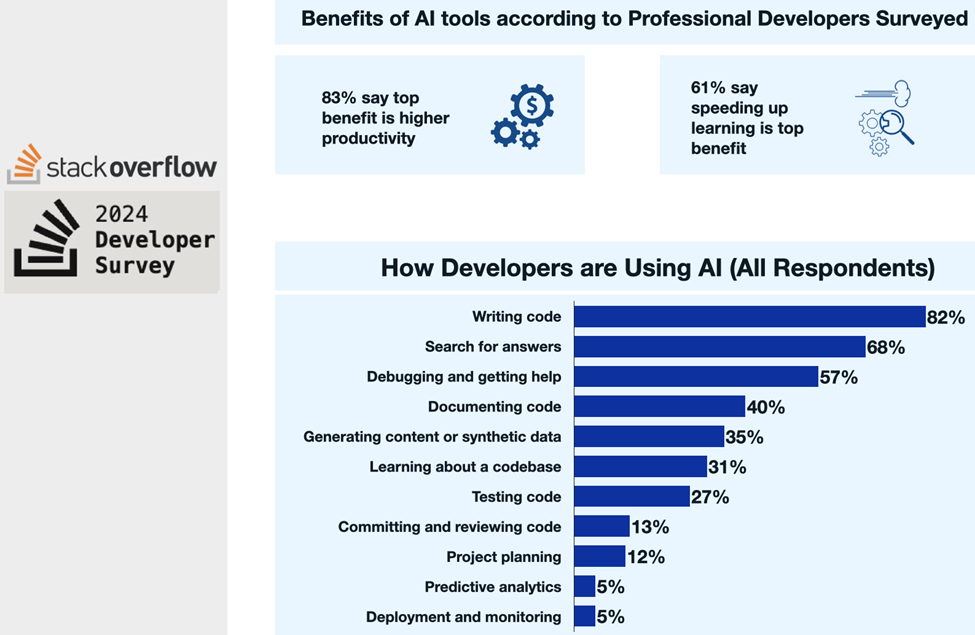
The complexity and cost of these advanced applications kept them accessible primarily to large enterprises, leaving smaller organizations struggling to catch up.
5. Smaller, Faster Models Trained on Less Data
The prediction that AI models would become faster, smaller, and less data-intensive proved accurate. Innovations in model compression and training techniques enabled the development of lightweight AI models such as Phi-3 and SmolLM, suitable for smartphones and other small devices.
This advancement unlocked new use cases, particularly in areas like on-device assistants, predictive maintenance for IoT devices, and personalized experiences in retail. Smaller models also addressed some privacy concerns, as they could operate locally without sending sensitive data to the cloud. Pelonomi Moiloa, CEO of Lelapa AI, made the prescient prediction that this would open the doors to implementing AI in parts of the world where not only data but also electricity and computing equipment are severely limited.
Phi-4 Beats Models Five Times Its Size
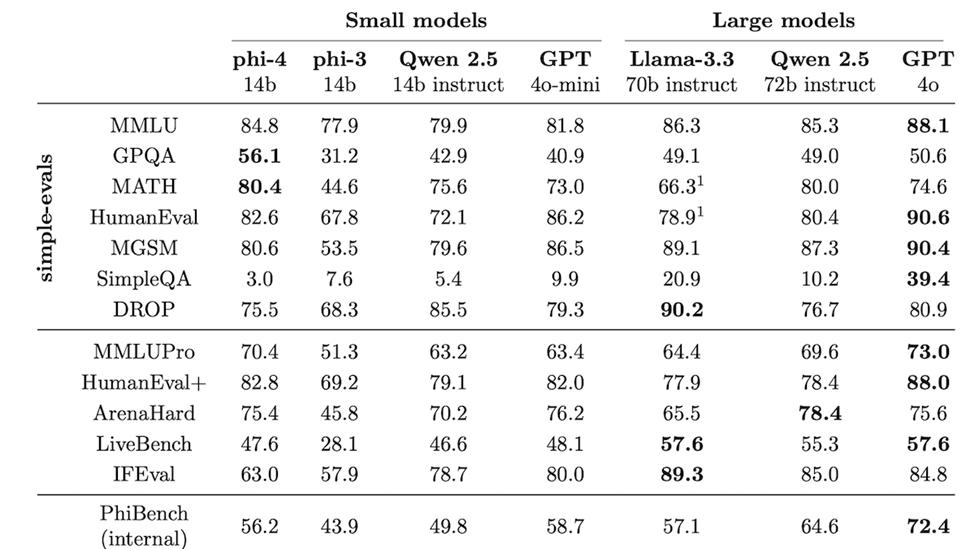
6. Domain-Specific AI Models
As predicted, 2024 saw increased focus on domain-specific models tailored for specific industries. Some models such as BioBERT were built from the ground up, while more commonly, providers customized and fine-tuned models for specific tasks. These models delivered better performance than general-purpose AI in areas like legal document analysis, financial risk assessment, and clinical diagnostics.
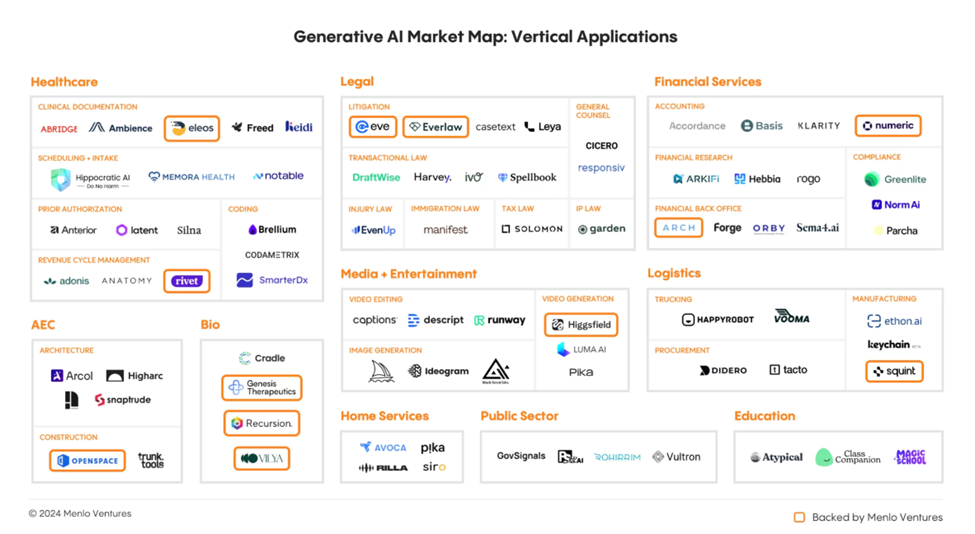
The rise of domain-specific models highlighted by the market map above underscored a broader trend toward specialization, as companies sought to address their unique challenges with customized AI solutions. These specialized systems offer a compelling value proposition for businesses seeking high ROI from their AI investments.
7. The Rise of AI Agents and Modular Systems
Peter Norvig (Stanford HAI) among others predicted the rise of agentic AI and “being able to connect to other services to actually do things”. An AI agent is an autonomous software program that uses artificial intelligence to interact with its environment, collect data, and perform series of steps to complete complex tasks for the user. Think of it as an AI that can order food, send emails, and perform other tasks on your behalf.
AI Agents for Research Idea Proposals

The idea of modular AI systems and intelligent agents gained momentum in 2024. Several tools emerged to help developers build agentic workflows including LangGraph and Llama Stack. These systems, capable of performing autonomous tasks by combining various AI models, saw significant development and tools such as Lindy gained traction among users. For example, AI agents were deployed to handle supply chain optimization and financial forecasting, demonstrating their potential to tackle complex, multi-step problems. Cognition AI claimed that its Devin platform was the first AI-powered software engineering platform that can complete entire coding projects from scratch with remarkable applications including building new websites from scratch.
However, the technology is still in its infancy and widespread adoption remains a future aspiration.
8. Regulatory Landscape
Regulation was another hot topic coming into 2024, with expectations that the EU would lead the charge while the US offered a more market-friendly, possibly fragmented approach. Jennifer King, Stanford HAI Privacy and Data Policy Fellow, suggested that companies would have to start thinking about navigating customers exercising their rights, particularly en masse This prediction largely held true.
The EU introduced stricter AI regulations under its AI Act, requiring companies to comply with transparency standards and risk assessments. Meanwhile, the US saw progress on AI policy at the state level and through industry self-regulation, but federal legislation remained limited. Companies operating globally had to navigate this patchwork of regulations, adding complexity to their AI initiatives.
Hopes, Fears, and Uncertainties: What 2024 Taught Us
1. GPU Shortages
One of the most pressing fears heading into 2024 articulated by Sara Hooker (VP of Research at Cohere) was a continued shortage of GPUs, the hardware backbone of AI. While shortages persisted early in the year, investments in semiconductor manufacturing and supply chain improvements helped alleviate the crisis by mid-2024. Companies also adapted through various strategies, including optimizing model efficiency and exploring novel computing architectures. However, demand for GPUs remains high, and organizations must plan strategically to secure the resources needed for their AI projects.
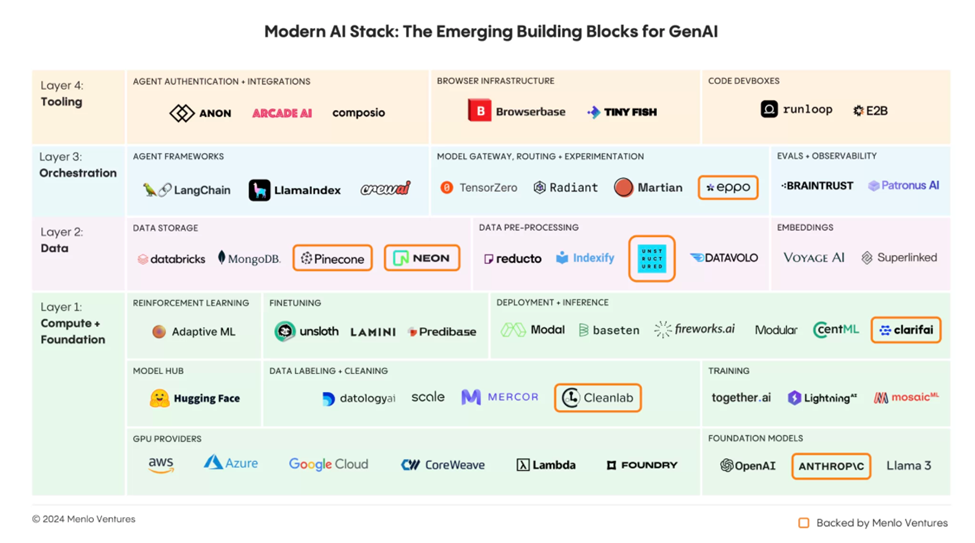
2. Policy, Transparency and Ethical Questions
2024 saw growing calls to address the ethical and societal implications of AI. Policymakers, industry leaders, and academics debated the long-term impacts of automation, data privacy, and the role of AI in decision-making. Experts emphasized the need for greater transparency in foundational models, urging companies to disclose how these systems were trained and ensure alignment with human values. Transparency initiatives gained traction, with several major AI companies providing more detailed information about their training processes and model characteristics. Progress was made, but challenges remain, particularly in defining universal standards for transparency and accountability.
3. Acknowledging the Human Costs
Another hope was that the industry would recognize the human effort and creativity behind AI development. Sasha Luccioni was especially vocal about this and highlighted issues of copyright and consent as well as unfair labor market practices in paying outsourced workers less than $2 an hour to label training data. While discussions about the human costs of AI gained traction, tangible action was limited. Ensuring that AI development becomes more human-centric will require sustained commitment from both industry and policymakers.
Key Takeaways from 2024
2024 was a pivotal year for AI, characterized by both progress and growing pains. The initial exuberance surrounding generative AI gave way to a more measured understanding of its challenges and opportunities. AI experts' more measured predictions generally proved more accurate than the more sensational forecasts that captured public attention. Grounded in fundamentals, they understood that meaningful transformation requires not just technological capability but also time, trust, and thoughtful implementation. While some predictions—such as catalyzing innovative discoveries and advancements in model efficiency and domain-specific AI—proved accurate, others, like widespread productivity gains, remain works in progress. Technical progress continued steadily throughout the year, while organizational and human factors emerged as key determinants of successful AI implementation.

Looking Ahead: Lessons for 2025
2025 promises to be another year of exponential growth in AI. The focus will shift from experimentation to operationalization. Organizations that invested in PoCs and pilots in 2024 are poised to scale their AI initiatives, driving real ROI and competitive advantage. This environment also presents an opportunity for those that have stayed on the sidelines to catch up, benefitting from the more mature technologies now available and clearer implementation pathways. But they must act soon, or they may find themselves at a disadvantage as the pace of AI innovation accelerates.
The lessons of 2024 are clear: AI is not a silver bullet, but a powerful tool that requires careful planning, investment, and adaptation. For executives and leaders, the challenge in 2025 will be to harness this technology effectively while navigating its complexities. Ensuring the requisite AI expertise (in-house or outsourced) to identify and align strategic imperatives is critical. The future of AI is bright, but it demands patience, pragmatism, and a commitment to responsible innovation.
------------------------------------------------------------------------
Subscribe to the AI newsletter and join the conversation on LinkedIn.
Have you begun to use AI yet? Or are you struggling to achieve tangible value from your deployments of AI to date?
Explore our offerings and acquire an expert partner today.

About The dAIta Solution
The dAIta Solution provides strategic consultancy, process and data mining, analytics, reporting and automation implementation solutions powered by AI that enable organizations to achieve their full potential hidden within the information that they possess. Our proprietary mining and analytics techniques and vendor-agnostic AI and data software streamlines the path to results and facilitates automation of both the analysis of your organization and implementing solutions to weaknesses or growth opportunities identified. Founded by senior consultancy services executives, data scientists and former EY leaders, The dAIta Solution is headquartered in Los Angeles with operations in London, Lagos and Singapore. For more information, please visit thedaitasolution.com.
Latest Resources
Want to see The dAIta Solution in action?
Get in touch now for a free demo of the platform, our products and services





